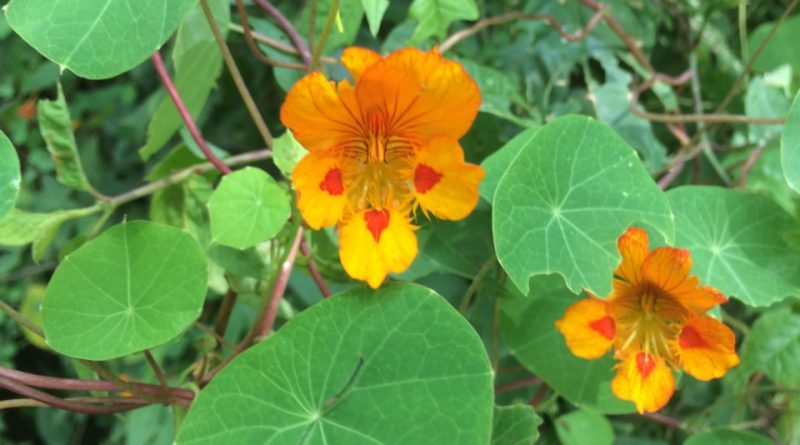Tropaeolum minus
Tropaeolum minus
The dwarf nasturtium (Tropaeolum minus L.) is a herbaceous species belonging to the Tropaeolaceae family.
Systematics –
From a systematic point of view it belongs to:
Eukaryota Domain,
Kingdom Plantae,
Magnoliophyta Division,
Superclass Rosidae,
Magnoliopsida class,
Order Geraniales,
Tropaeolaceae family,
Genus Tropaeolum,
T. minus species.
The terms are synonymous:
– Cardamindum minus (L.) Moench;
– Tropaeolum dentatifolium Stokes;
– Tropaeolum minus var. brunneum Vilm.;
– Tropaeolum minus var. coccineum Vilm.;
– Tropaeolum minus var. schillingii Vilm.;
– Tropaeolum minus var. tompouce Vilm.;
– Tropaeolum pulchellum Salisb.;
– Trophaeum minus (L.) Kuntze.
Etymology –
The term Tropaeolum is the diminutive coming from the Greek τρóπαιον trópaion trophy: for the showiness of the flowers.
The specific epithet minus is the comparative of párvus: minor, smaller than the congener species.
Geographic Distribution and Habitat –
The dwarf nasturtium is a plant native to an area ranging from Ecuador to Peru.
Its habitat is that of humid places where it still grows at the highest altitudes.
Description –
The dwarf nasturtium is a perennial or annual herbaceous plant that grows to about 30 – 50 cm in height.
The stems are thin herbaceous, covered with rounded leaves, shield-shaped and up to 8 cm wide, light green in color and bordered by tiny teeth where the veins meet the leaf margin.
The flowers are orange or reddish orange, with pointed tips on the petals and sometimes with purple veins or with red spots at the base; these are carried singularly to the axil of the leaves from the beginning of the summer to the autumn.
The flowers are zygomorphic and the calyx is composed of five sepals, one of which is characterized by a spur-like elongation. Similarly, the corolla is also composed of five petals. Each flower has eight stamens and an upper ovary, consisting of three carpels.
Cultivation –
Tropaeolum minus is a perennial or annual plant that produces edible flowers, leaves and seeds, has insect repellent properties and various medicinal applications.
This plant is also cultivated as an ornamental, although it has been largely supplanted in the garden by Tropaeolum majus and by hybrids between the two species.
For its cultivation it should be taken into account that it is a plant that grows at higher altitudes in the tropics and can be grown as a summer annual in the temperate zone.
From a pedological point of view, it prefers a rich, light and well-drained soil in full sun or partial shade.
When the plant grows in rich soil, even though fewer flowers are produced, it still produces more and more lush leaves.
Propagation occurs by seed with sowing directly in the open field. The seed usually germinates within 2 weeks. The seeds can also be sown in March in pots or greenhouses (in colder areas) and planted in late spring or early summer.
Customs and Traditions –
Tropaeolum minus is used mainly in the areas of origin both as a food plant and for medicinal uses.
For food use raw flowers are consumed. The flowers contain about 130 mg of vitamin C per 100 g.
Young raw pods and both raw and cooked seeds are also consumed.
Ripe seed can be ground into a powder and used as a pepper substitute.
In medicinal use, the whole plant is antibiotic, antiseptic, aperient, diuretic and expectorant.
It is useful for loosening respiratory tract and chest congestion during colds.
A juice or tea made from the plant can be used as an external or internal antiseptic.
The plant has antibiotic properties against aerobic spore-forming bacteria. It is also said to have a beneficial effect on the blood by promoting the formation of red blood cells.
Other uses include agroforestry ones. Additionally, the growing plant attracts aphids away from other plants. Research indicates that aphids flying over plants with orange or yellow flowers do not stop, nor do they prey on plants that grow near or on top of the flowers.
Finally, an insecticide can be obtained from the plant from an infusion of soap leaves and flakes.
Preparation Method –
Tropaeolum minus is a plant that was used, especially in the past, both in the food and medicinal fields.
All parts of the plant are used, such as raw flowers or even young raw pods and both raw and cooked seeds.
From the ground ripe seed, a powder is obtained which is used as a substitute for pepper.
Guido Bissanti
Sources
– Acta Plantarum – Flora of the Italian Regions.
– Wikipedia, the free encyclopedia.
– GBIF, the Global Biodiversity Information Facility.
– Useful Tropical Plants Database.
– Conti F., Abbate G., Alessandrini A., Blasi C. (ed.), 2005. An annotated checklist of the Italian vascular flora, Palombi Editore.
– Pignatti S., 1982. Flora of Italy, Edagricole, Bologna.
– Treben M., 2000. Health from the Lord’s Pharmacy, Advice and experiences with medicinal herbs, Ennsthaler Editore.
Photo source:
– https://inaturalist-open-data.s3.amazonaws.com/photos/23688223/original.jpeg
Warning: Pharmaceutical applications and alimurgical uses are indicated for informational purposes only, they do not represent in any way a medical prescription; therefore no responsibility is taken for their use for curative, aesthetic or food purposes.


